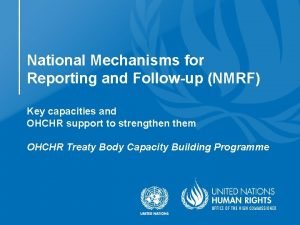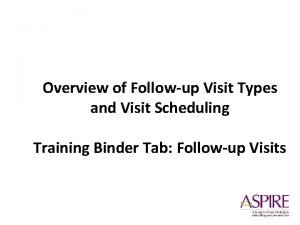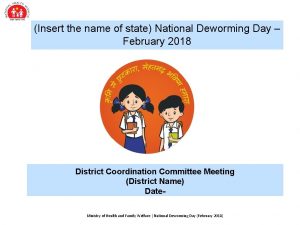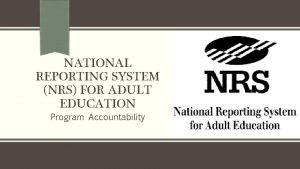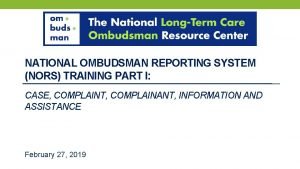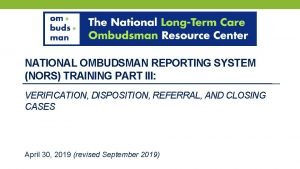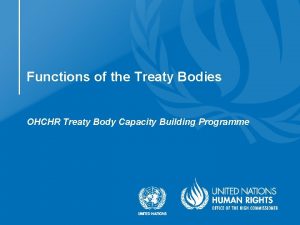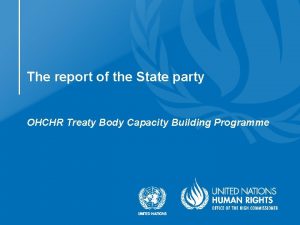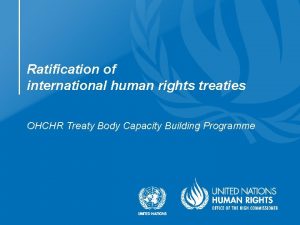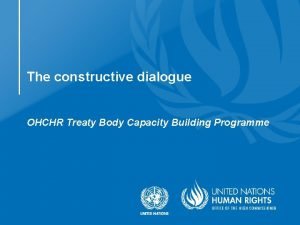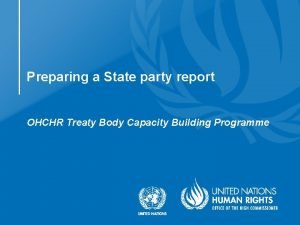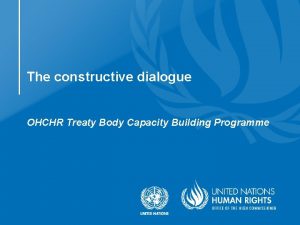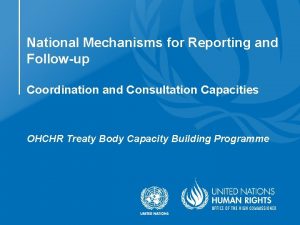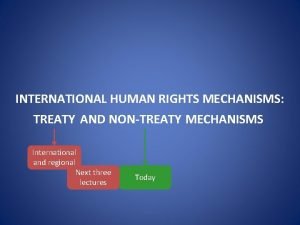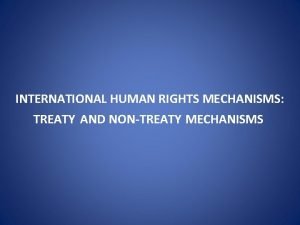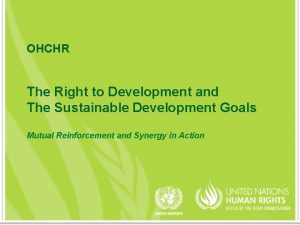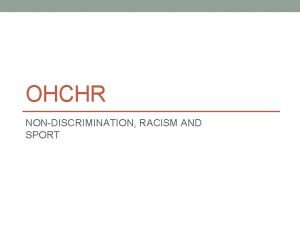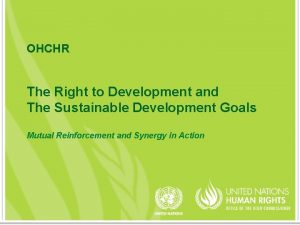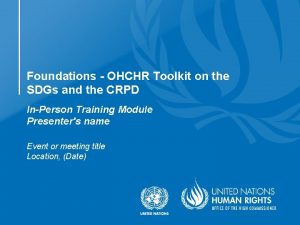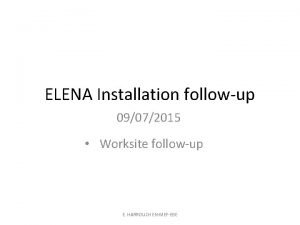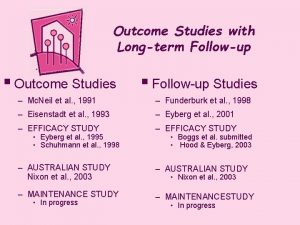National Mechanisms for Reporting and Followup OHCHR Treaty




























- Slides: 28

National Mechanisms for Reporting and Follow-up OHCHR Treaty Body Capacity Building Programme

Rational for institutionalizing State engagement with HRMs Type Mandate Main Functions UPR Intergovernmental Human Rights Council - Reporting SPs Independent experts Human Rights Council - Visits - Individual complaints TBs Independent experts Human Rights treaties - Reporting - Individual complaints - Visits (by 1 TB- SPT) ALL THREE MECHANISMS ISSUE RECOMMENDATIONS

National Challenges § Ongoing growth in human rights mechanisms (int’l and regional), reporting requirements, and number of human rights recommendations addressed to States § Timely and quality reporting demand sustainable technical expertise § Quality reporting requires effective follow-up and implementation of recommendations by many Ministries and at the local level Ad-hoc arrangements are not viable anymore

Standing. /. Ad hoc § Increased coordination, institutional memory (also because of delay between submission of report and its review) § Better use of resources § Better horizontal linkages § Better monitoring of follow-up § National coherence § Easier to support with technical assistance

A comprehensive national approach A rapidly increasing number of States have therefore adopted a comprehensive, efficient approach to reporting and follow-up by institutionalizing existing arrangements into a National Mechanism for Reporting and Follow-up (NMRF)

Calls at the international level for NMRFs § The HC’s 2012 report to the GA on Strengthening the United Nations Human Rights Treaty Body System § UN GA resolution 68/268 on Strengthening and enhancing the effective functioning of the human rights treaty body system § Recommendations by States during the UPR and TB reviews Ø Practical Guide and Study on NMRFs (released in June 2016)

What is a National Mechanism for Reporting and Follow-up (NMRF)? An institutionalization of current inter-ministerial coordination structures or processes around human rights reporting, moving away from ad hoc to sustainable arrangements which facilitate implementation of recommendations addressed to States. Ø Coordinate and prepare reports to and engage with the international and regional human rights mechanisms (including Treaty Bodies, the Universal Periodic Review and Special Procedures) Ø Coordinate and track national follow-up and implementation of the treaty obligations and recommendations/ decisions emanating from these mechanisms.

What are the main types of NMRFs? Ad-hoc Based within a ministry Interministerial Separate institution

Ad hoc NMRFs § Created purely for the purpose of completing a specific report and is disbanded when it delivers that report § Established by an individual ministry or by an interministerial committee § Does not retain any institutional capacity, practices, network or knowledge, as it is disbanded after completing the task § Usually has no objective or mandate for the followup to recommendations from international and regional human rights mechanisms § May make use of standardized reporting and coordination practices

Organigramme - ad hoc NMRF Lead Ministry (depending on Treaty) Ad hoc drafting committee

Ministerial NMRF § Standing mechanism based within a single government ministry drawing on other Ministries expertise and information depending on the subject matter (for example Mexico) § Is maintained by the relevant ministry beyond the completion of a report § Retains its institutional capacity, practices, network or knowledge for reporting and follow-up; however, it does so within one ministry

Organigramme Ministerial NMRF Example: Ministry of Foreign Affairs Ministry Department Unit Drafting committee (calling upon other Ministries depending on task ) Unit

Inter-Ministerial NMRF § A standing mechanism convened across two or more ministries through a joint structure § Often serviced by an executive secretariat located in one Ministry, such as the Ministry of Foreign Affairs (Portugal) or the Ministry of Justice (Senegal)/ the Attorney General’s Office (Bahamas), or the Office of the Prime Minister (Mauritius, Tunisia), that coordinates information collection, services the meetings of the national mechanism and compiles a first draft of reports § Mostly established through a formal legislative mandate § Regularly convenes its network of members as well as ministerial human rights focal points § Retains its institutional capacity, practices, network and knowledge for reporting and follow-up § Mainstreams human rights and builds key reporting and coordination capacities across multiple ministries

Organigramme - Inter-Ministerial NMRF Chairmanship (ex. : Ministry of Foreign Affairs) NMRF Secretariat (ex. HR Division) Minister Minister Focal point Focal point Drafting Working Group

Institutionally separate NMRF § A separate institution established by the Government and responsible for coordination, report writing and consultation (Morocco) § Endowed with a separate budget, separate staff, and structured into internal directorates, programmes and subprogrammes § Institutionalized and maintained by the Government beyond the completion of individual reports § Retains its skills and knowledge, and is able to control its own budget and appoint staff independently

Organigramme Institutionally separate NMRF Separate institution Head of NMRF Directorate (Engagement/ drafting reports/ information management including monitoring implementation) Directorate (Coordination within Government) Directorate (Consultation with NHRI and CSOs) Division of Administrative Affairs

Key features § A Governmental structure § Comprehensive (covers all human rights mechanisms -UPR, TBs, Special Procedures- all human rights- all outcomes: recommendations, decisions, and views) § Standing/ permanent. /. Ad hoc § Comprehensive formal legislative or policy mandate ensuring political ownership (empower within Ministries) • Legislation (passed through Parliament) • Formal regulation (by the Executive, but not through Parliament) • Policy mandate (formed after the adoption of an Executive/Ministerial policy provision) § Budget (forward planning within each Ministries budgets) § Continuity and technical expertise of staff (train staff, institutional memory, gender sensitivity and gender parity) § And four key capacities

Four key capacities of a NMRF An effective NMRF should have the following four key capacities: § Engagement capacity § Coordination capacity § Consultation capacity § Information management capacity

Engagement capacity The capacity to engage and liaise with international and regional human rights bodies and organize and centrally facilitate the preparation of reports and responses to international and regional human rights mechanisms This may include - a dedicated capacity and knowledge (e. g. through the establishment of a permanent Executive Secretariat for such purposes with trained staff knowing about each international human rights mechanism) - Ministerial focal points - the establishment of standardized internal reporting guidelines and procedures or checklists to organize Special Procedures visits

Engagement capacity- CHECKLIST § § § § Establish an executive secretariat to support the work of the NMRF Build the capacity of the executive secretariat for engagement with international human rights mechanisms, but also for drafting and presentation Establish a network of focal points in each ministry, appointed by each minister, for drafting and information-sharing purposes Establish standardized reporting guidelines and procedures for the national mechanism’s members and focal points to follow Make an inventory of upcoming universal periodic review and treaty body reporting obligations, as well as forthcoming special procedure mandate holder visits and visits of the Subcommittee on Prevention of Torture Develop a work plan and calendar of activities together with timelines, assignment of responsibilities and estimated costs (of participation in dialogues, for example) Establish specific drafting groups from among the network of focal points (e. g. , under the coordination of the mechanism’s executive secretariat) organized for each of the human rights treaties ratified; or focusing on groups of rights; or for a specific upcoming report

Coordination capacity The capacity and authority to disseminate information, and to organize and coordinate information gathering and data collection from government entities, but also other State actors such as the national office for statistics, SDG implementation focal point “agency/Ministry”, parliament and the judiciary, for reporting and follow-up to recommendations This may include: - a solid mandate, terms of reference, and annual work plans engaging all relevant Ministries, the National Statistics Office and SDG focal point (lead agency/Ministry) - Email lists and regular coordination meetings - Use of templates for collecting information - Standing procedures for coordination with Parliament

Coordination capacity - CHECKLIST § § § Hold regular (plenary) meetings of the national mechanism Draw up a calendar of regular coordination meetings with all ministerial focal points and establish an e‑mail list to allow for regular information sharing During the regular plenary and/or focal point meetings include debriefings by the head of delegation on the universal periodic review and interactive dialogues before treaty bodies and the recommendations received For an upcoming report, (a) hold a preparatory meeting of the national mechanism to explain how the relevant human rights mechanism works and outline the structure and content of the upcoming report; and (b) send a template/table to the members of the national mechanism and the focal points listing previous recommendations with the responsible line ministries, with a request for information and/or draft input for the periodic report, including word limits and submission deadlines Through the ministry of justice, transmit recommendations from human rights mechanisms to various levels of the judiciary and collect information on human rights-related cases from the courts Establish a standing procedure to interact with parliament, for example informing parliament on the reporting/review process, submitting draft reports for comments, forwarding recommendations, and liaising between parliament and special procedure mandate holders

Consultation capacity The capacity to foster and lead consultations with the country’s NHRI(s) and civil society This may include: - a dedicated focal point for liaising with other stakeholders - Establishing a mailing list - regular consultations with different stakeholders - Participation of stakeholders in selected meetings (observer)

Consultation capacity- CHECKLIST § § § § § Draw up a calendar of consultations with all stakeholders keeping in mind reporting deadlines If institutionally separate, the national mechanism can create a separate directorate for coordination with the NHRI and civil society Otherwise, it can establish a “desk” for consulting with the NHRI and civil society during the drafting process Systematically include NHRI representatives in the national mechanism’s structure and working groups, and in plenary meetings (without voting rights in order to preserve their independence in line with the Paris Principles) Send draft reports to NHRIs for comments Establish an NGO contact network and mailing list Invite civil society to participate periodically in selected plenary or focal point meetings Hold subject-specific meetings with civil society (including in response to requests from civil society groups) Circulate the minutes of plenary meetings and/or meetings with civil society among the civil society network

Information management capacity The capacity of a NMRF to § track the issuance of recommendations and decisions by the international and regional human rights mechanisms § systematically capture and thematically cluster (including against SDGs) these recommendations and decisions in a user-friendly spread sheet or database § identify responsible Government ministries and/or agencies for their implementation § develop HRM recommendations implementation plans, which can feed into any other national action plan or roadmap, including time-lines, with relevant ministries to facilitate such implementation and indicators § manage information regarding the implementation of treaty provisions and recommendations, including with a view to preparing the next periodic report

Information management capacity-CHECKLIST § § § § Cluster recommendations by theme, analyse and prioritize them, and circulate clustered and prioritized recommendations among members and focal points Keep those lists up to date Develop, based on these clustered and prioritized lists, a HRM recommendations implementation plan (word-processing file, spreadsheet or database) or a national human rights action plan, feed into SDG implementation plan or other national action plans (as applicable) and track its implementation If a database is used, keep it up to date, recording progress in the implementation of recommendations from human rights mechanisms, and make it public (e. g. , Paraguay) During the regular plenary meetings ask members to report back at the end of the year on how their respective ministries have implemented recommendations addressed to them in the implementation plan or national human rights action plan and what they have done to implement their pledges under the universal periodic review Issue an annual report and make it public Create a website and/or social media presence If institutionally separate, include a separate directorate within the national mechanism responsible for tracking progress in the implementation of recommendations from human rights mechanisms

Conclusions An effectively functioning NMRF § Establishes a national coordination structure, thereby creating national ownership of reporting and follow-up and regular interaction within ministries and with ministries engaging seriously in reporting and follow-up § Makes communication between ministries easier and more direct, thereby creating efficiencies and maximizing resources § Systematizes and rationalizes the engagement with international and regional human rights mechanisms, including the preparation of reports, and coordinates follow-up, thereby ensuring national coherence § Empowers ministerial focal points to communicate and explain the human rights system and its recommendations within their ministries, thereby actively contributing to the development of policies and practices § Allows for structured and formalized contacts with parliament, the judiciary, NHRI and civil society, thereby mainstreaming human rights at the national level, strengthening public discourse on human rights, and improving transparency and accountability § Builds professional human rights expertise in every State

Engagement capacity Coordination capacity Standing Types Comprehensive NMRF Mandate Budget Consultation capacity Information management capacity
 National mechanism for reporting and follow-up
National mechanism for reporting and follow-up Followup edge
Followup edge Followup:actionitems
Followup:actionitems Follow-up visits
Follow-up visits Ndd reporting format 2021
Ndd reporting format 2021 Ndd reporting format 2021
Ndd reporting format 2021 National reporting system
National reporting system Deworming poster images
Deworming poster images National ombudsman reporting system
National ombudsman reporting system National ombudsman reporting system
National ombudsman reporting system National unification and the national state
National unification and the national state Kontinuitetshantering i praktiken
Kontinuitetshantering i praktiken Typiska novell drag
Typiska novell drag Nationell inriktning för artificiell intelligens
Nationell inriktning för artificiell intelligens Returpilarna
Returpilarna Varför kallas perioden 1918-1939 för mellankrigstiden?
Varför kallas perioden 1918-1939 för mellankrigstiden? En lathund för arbete med kontinuitetshantering
En lathund för arbete med kontinuitetshantering Särskild löneskatt för pensionskostnader
Särskild löneskatt för pensionskostnader Tidbok för yrkesförare
Tidbok för yrkesförare A gastrica
A gastrica Förklara densitet för barn
Förklara densitet för barn Datorkunskap för nybörjare
Datorkunskap för nybörjare Stig kerman
Stig kerman Hur skriver man en tes
Hur skriver man en tes För och nackdelar med firo
För och nackdelar med firo Nyckelkompetenser för livslångt lärande
Nyckelkompetenser för livslångt lärande Påbyggnader för flakfordon
Påbyggnader för flakfordon Kraft per area
Kraft per area Svenskt ramverk för digital samverkan
Svenskt ramverk för digital samverkan
